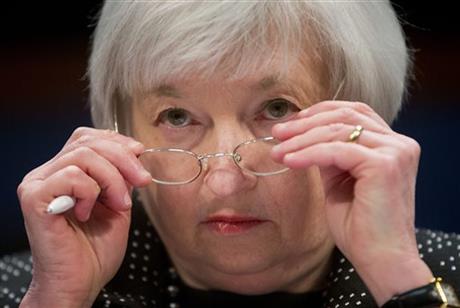- California Assembly OKs highest minimum wage in nation
- S. Korea unveils first graphic cigarette warnings
- US joins with South Korea, Japan in bid to deter North Korea
- LPGA golfer Chun In-gee finally back in action
- S. Korea won’t be top seed in final World Cup qualification round
- US men’s soccer misses 2nd straight Olympics
- US back on track in qualifying with 4-0 win over Guatemala
- High-intensity workout injuries spawn cottage industry
- CDC expands range of Zika mosquitoes into parts of Northeast
- Who knew? ‘The Walking Dead’ is helping families connect
Fed finally lifts key interest rate from near zero

In this Feb. 25, 2015, file photo, Federal Reserve Chair Janet Yellen removes her glasses as she testifies on Capitol Hill in Washington. The Federal Reserve is widely expected to raise its key rate from record lows, on Wednesday, Dec. 16, 2015, potentially heralding higher lending rates in an economy much sturdier than the one the Fed helped rescue in 2008 with borrowing rates near zero. (AP Photo/Pablo Martinez Monsivais, File)
WASHINGTON (AP) — The Federal Reserve is raising interest rates after seven years of record lows. But it’s signaling that further rate hikes will likely be made slowly as the economy strengthens further and muted inflation rises.
The Fed’s move Wednesday to lift its key rate by a quarter-point to a range of 0.25 percent to 0.5 percent ends an extraordinary seven-year period of near-zero rates that began at the depths of the 2008 financial crisis. Consumers and businesses could now face modestly higher rates on some loans.
The Fed’s action reflects its belief that the economy has finally regained enough strength 6½ years after the Great Recession ended to withstand higher borrowing rates. But the statement announcing the rate hike said the committee now expects “only gradual increases” in rates.
Investors’ immediate reaction to the Fed’s announcement, which was widely anticipated, was muted. Stocks moved slightly up. Higher interest rates in the U.S. tend to cause the dollar to strengthen against other currencies.
The bond market didn’t’ react much. The yield on the 10-year Treasury note held steady at 2.27 percent.
Rates on mortgages and car loans aren’t expected to rise much soon. The Fed’s benchmark rate doesn’t directly affect them. Long-term mortgages, for example, tend to track 10-year U.S. Treasury yields, which will likely stay low as long as inflation does and investors keep buying Treasurys.
But rates on some other loans, like credit cards and home equity credit lines, will likely rise, though probably only slightly as long as the Fed’s rate hikes remain modest.
Shortly after the Fed’s announcement, major banks began announcing that they were raising their prime lending rate from 3.25 percent to 3.50 percent. The prime rate is a benchmark for some types of consumer loans such as home equity loans. Wells Fargo was the first bank to announce the rate hike.
For months, Chair Janet Yellen and other Fed officials have said they expected any rate hikes to be small and gradual. But nervous investors have been looking for further assurances.
An updated economic forecast released with the policy statement showed that 14 of the 17 Fed officials foresee four or fewer rate hikes in 2016. That is in line with the consensus view of economists that the Fed’s target for the federal funds rate — the that banks charge on overnight loans — will end next year around 1 percent.
The Fed’s action was approved by a unanimous vote of 10-0, giving Yellen a victory in achieving consensus.
The Fed statement struck a generally more upbeat tone in its assessment of the economy. It cited “considerable improvement” in the job market. And it expressed more confidence that inflation, which has been running well below the Fed’s 2 percent target, would begin rising. It suggested that this would happen as the effects of declines in energy and import prices fade and the job market strengthens further.
The central bank’s target for the federal funds rate — the interest that banks charge each other — has been at a record low between zero and 0.25 percent since December 2008. At the time, Fed officials led by Ben Bernanke were struggling to contain a devastating financial crisis that triggered the worst recession since the Great Depression.
The recession officially ended in June 2009. But unemployment kept rising, peaking at 10 percent before starting to fall. The jobless rate is now at a seven-year low of 5 percent, close to the Fed’s target for full employment.















